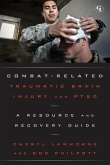- Gebundenes Buch
- Merkliste
- Auf die Merkliste
- Bewerten Bewerten
- Teilen
- Produkt teilen
- Produkterinnerung
- Produkterinnerung
The Lefaivre Rainbow Effect is a groundbreaking treatment for those suffering from a traumatic brain injury. This textbook is the culmination of more than 25 years of successfully implementing this transformative treatment pioneered by the author. The book demonstrates how rehabilitation professionals, including occupational therapists, doctors, nurses, social workers, speech pathologists, and neuropsychologists, can use the Lefaivre Rainbow Effect in their practices to improve the therapeutic outcome for their clients. It discusses the dual role healthcare providers have of delivering care to…mehr
Andere Kunden interessierten sich auch für
![Neurosensory Disorders in Mild Traumatic Brain Injury Neurosensory Disorders in Mild Traumatic Brain Injury]() Neurosensory Disorders in Mild Traumatic Brain Injury163,99 €
Neurosensory Disorders in Mild Traumatic Brain Injury163,99 €![The Knee Injury Bible The Knee Injury Bible]() Jorge ChahlaThe Knee Injury Bible22,99 €
Jorge ChahlaThe Knee Injury Bible22,99 €![Combat-Related Traumatic Brain Injury and PTSD Combat-Related Traumatic Brain Injury and PTSD]() Cheryl Lawhorne-ScottCombat-Related Traumatic Brain Injury and PTSD15,99 €
Cheryl Lawhorne-ScottCombat-Related Traumatic Brain Injury and PTSD15,99 €![Estrogen Effects on Traumatic Brain Injury Estrogen Effects on Traumatic Brain Injury]() Estrogen Effects on Traumatic Brain Injury109,99 €
Estrogen Effects on Traumatic Brain Injury109,99 €![Geriatric Rehabilitation Geriatric Rehabilitation]() Geriatric Rehabilitation238,99 €
Geriatric Rehabilitation238,99 €![Introduction to Non-Invasive EEG-Based Brain-Computer Interfaces for Assistive Technologies Introduction to Non-Invasive EEG-Based Brain-Computer Interfaces for Assistive Technologies]() Introduction to Non-Invasive EEG-Based Brain-Computer Interfaces for Assistive Technologies100,99 €
Introduction to Non-Invasive EEG-Based Brain-Computer Interfaces for Assistive Technologies100,99 €![Executive Functions and the Frontal Lobes Executive Functions and the Frontal Lobes]() Executive Functions and the Frontal Lobes70,99 €
Executive Functions and the Frontal Lobes70,99 €-
-
-
The Lefaivre Rainbow Effect is a groundbreaking treatment for those suffering from a traumatic brain injury. This textbook is the culmination of more than 25 years of successfully implementing this transformative treatment pioneered by the author. The book demonstrates how rehabilitation professionals, including occupational therapists, doctors, nurses, social workers, speech pathologists, and neuropsychologists, can use the Lefaivre Rainbow Effect in their practices to improve the therapeutic outcome for their clients. It discusses the dual role healthcare providers have of delivering care to maximize recovery, coupled with the necessity to submit medical legal reports to an adversarial system.
Hinweis: Dieser Artikel kann nur an eine deutsche Lieferadresse ausgeliefert werden.
Hinweis: Dieser Artikel kann nur an eine deutsche Lieferadresse ausgeliefert werden.
Produktdetails
- Produktdetails
- Verlag: Apple Academic Press Inc.
- Seitenzahl: 368
- Erscheinungstermin: 1. August 2014
- Englisch
- Abmessung: 277mm x 173mm x 18mm
- Gewicht: 846g
- ISBN-13: 9781482228243
- ISBN-10: 1482228246
- Artikelnr.: 40493746
- Herstellerkennzeichnung
- Libri GmbH
- Europaallee 1
- 36244 Bad Hersfeld
- 06621 890
- Verlag: Apple Academic Press Inc.
- Seitenzahl: 368
- Erscheinungstermin: 1. August 2014
- Englisch
- Abmessung: 277mm x 173mm x 18mm
- Gewicht: 846g
- ISBN-13: 9781482228243
- ISBN-10: 1482228246
- Artikelnr.: 40493746
- Herstellerkennzeichnung
- Libri GmbH
- Europaallee 1
- 36244 Bad Hersfeld
- 06621 890
Christine Lefaivre O.T.(C) is a registered occupational therapist, President of Rainbow Rehabilitation Inc., and a clinical Assistant Professor at the University of British Columbia, Canada.
The Human Spirit. Introduction. The Human Spirit. Forgiveness. Loss.
Principles That Preserve Hope. Summary. Appendix 1A: Kubler-Ross's Five
Stages of Grief. The Lefaivre Rainbow Effect. Introduction. How the
Lefaivre Rainbow Effect Came to Be. The Theory of the Rainbow Effect. The
Approach. The Philosophy. The Assumptions. The Lefaivre Rainbow Effect
Formula. Elements of the Rainbow Effect Formula. The Process of the
Rainbow Effect. Providers of Services. Summary. Appendix 2A: Definitions of
Service Providers. Total Sum. Introduction. Determining the Total Sum. How
This Approach Differs from Current Trends. Preparing for the History
Intake. Advocating to the Funder. The Process of Determining the Total Sum.
Establishing the Community Team. The History-Taking Process. Suggestions
for Taking a Client's History. Balanced Lifestyle Inventory. Clinician
Self-Assessment. Summary. Appendix 3A: History-Taking Template. Appendix
3B: Balanced Lifestyle Sheet. Appendix 3C: Severity of Brain Injury
Stratification. Appendix 3D: Post-traumatic Amnesia. Appendix 3E: Glasgow
Coma Scale. Glasgow Coma Scale. Appendix 3F: Rancho Los Amigos Scale:
Levels of Cognitive Functioning. Appendix 3G: Form 1: Clinician
Self-Checklist for Establishing Therapeutic Rapport. Appendix 3H: Form 2:
Clinician Self-Checklist for Determining the Total Sum. The Loss. The Loss.
The Process of Transferring the Client from. Hospital to Home and
Community. Case Manager. Initial Clinical Reports Produced by Community.
Clinicians. Preparing for the Team Meeting. Summary of How the Case Manager
will Run a. Team Meeting. Summary. Appendix 4A: Cross-Reference of
Assessment Tools and Sectors of Balanced Lifestyle Example for an
Occupational Therapist. Educating the Family. Introduction. Family Meeting.
Burn Blister Analogy. Introducing Stress. The Interplay between Stress and
Organic Symptoms. Summary. The Loss...Stress. Stress. The Process for
Managing Stress. Summary. The Traumatically-Induced Dysfunctional Family
Theory. Introduction. Systems in General. Family Systems. Ideal Conditions
for Best Clinical Outcomes. Outcomes with Clinical Intervention. Summary.
Intervention. Introduction. Setting the Stage for the Intervention.
Assumptions. The Brain-A Brief Overview. Limbic System. Memory. Sensory
Overload: Analogy of a Breaker Box. Some Causes of Sensory Overload. Energy
Conservation. Setting Goals. Observations. Cognitive Retraining Strategies.
Useful Therapeutic Hints. Summary. Residual Loss Cost-of-Future-Care
Analysis. Introduction. Helpful Hints for Preparing a Cost-of-Future-. Care
Analysis. Summary. Appendix 9A: Template for Creating a Cost-of-.
Future-Care Analysis. Litigation. Introduction. The Litigation Process. The
Expert Witness. Important Points to Remember for the Expert Witness.
Medical Legal Report Writing. My To-Do's Preparing to Go to Court. Expert
Witness Testimony. Summary. Appendix 10A: Litigation Terms Defined.
Business Practices and Public Relations. Introduction. What Does a Good
Business Profile Look Like?. Establishing a Professional Profile in the
Start-Up Phase. Enhancing Your Image: Public Relations. Summary. Four-Week
Time Management System. Introduction. The Premise. Goals of the Time
Management System. The Process. How the Time Management System Works. Case
Histories and To-Do's for Time Management System. The 4-Week Schedule.
Quality Statistics. How to Prepare Quality Statistics. Summary. Diverse
Funding. Introduction. Funding Sources. Tort Claims. Partial No-Fault
System. No-Fault System. Government Funding. Medication. Vocational
Retraining. Disability Tax Credit. Workers' Compensation. Veterans Affairs
and Military Benefits. Aboriginal Affairs. Victims Assistance. Blue Cross
and Blue Shield. Private Disability Insurance. Homeowner Insurance. Travel
Insurance. Alternate Sources of Funding for Service Provision. Private
Funding. Fund-Raising. Summary. The Use of Volunteers. Introduction. The
Use of Volunteers. The Recruitment of University or College Students.
Orientation and Education of Volunteers. Summary. Ethical Considerations.
Introduction. Prevention Identification of Risk Factors and. Improvement of
Public Policy. International Sharing of Information and Standards.
Specialized Training. Barriers. Selection of Community Service Providers.
Summary. Glossary of Terms. References. Appendix: Brain Injury
Associations.
Principles That Preserve Hope. Summary. Appendix 1A: Kubler-Ross's Five
Stages of Grief. The Lefaivre Rainbow Effect. Introduction. How the
Lefaivre Rainbow Effect Came to Be. The Theory of the Rainbow Effect. The
Approach. The Philosophy. The Assumptions. The Lefaivre Rainbow Effect
Formula. Elements of the Rainbow Effect Formula. The Process of the
Rainbow Effect. Providers of Services. Summary. Appendix 2A: Definitions of
Service Providers. Total Sum. Introduction. Determining the Total Sum. How
This Approach Differs from Current Trends. Preparing for the History
Intake. Advocating to the Funder. The Process of Determining the Total Sum.
Establishing the Community Team. The History-Taking Process. Suggestions
for Taking a Client's History. Balanced Lifestyle Inventory. Clinician
Self-Assessment. Summary. Appendix 3A: History-Taking Template. Appendix
3B: Balanced Lifestyle Sheet. Appendix 3C: Severity of Brain Injury
Stratification. Appendix 3D: Post-traumatic Amnesia. Appendix 3E: Glasgow
Coma Scale. Glasgow Coma Scale. Appendix 3F: Rancho Los Amigos Scale:
Levels of Cognitive Functioning. Appendix 3G: Form 1: Clinician
Self-Checklist for Establishing Therapeutic Rapport. Appendix 3H: Form 2:
Clinician Self-Checklist for Determining the Total Sum. The Loss. The Loss.
The Process of Transferring the Client from. Hospital to Home and
Community. Case Manager. Initial Clinical Reports Produced by Community.
Clinicians. Preparing for the Team Meeting. Summary of How the Case Manager
will Run a. Team Meeting. Summary. Appendix 4A: Cross-Reference of
Assessment Tools and Sectors of Balanced Lifestyle Example for an
Occupational Therapist. Educating the Family. Introduction. Family Meeting.
Burn Blister Analogy. Introducing Stress. The Interplay between Stress and
Organic Symptoms. Summary. The Loss...Stress. Stress. The Process for
Managing Stress. Summary. The Traumatically-Induced Dysfunctional Family
Theory. Introduction. Systems in General. Family Systems. Ideal Conditions
for Best Clinical Outcomes. Outcomes with Clinical Intervention. Summary.
Intervention. Introduction. Setting the Stage for the Intervention.
Assumptions. The Brain-A Brief Overview. Limbic System. Memory. Sensory
Overload: Analogy of a Breaker Box. Some Causes of Sensory Overload. Energy
Conservation. Setting Goals. Observations. Cognitive Retraining Strategies.
Useful Therapeutic Hints. Summary. Residual Loss Cost-of-Future-Care
Analysis. Introduction. Helpful Hints for Preparing a Cost-of-Future-. Care
Analysis. Summary. Appendix 9A: Template for Creating a Cost-of-.
Future-Care Analysis. Litigation. Introduction. The Litigation Process. The
Expert Witness. Important Points to Remember for the Expert Witness.
Medical Legal Report Writing. My To-Do's Preparing to Go to Court. Expert
Witness Testimony. Summary. Appendix 10A: Litigation Terms Defined.
Business Practices and Public Relations. Introduction. What Does a Good
Business Profile Look Like?. Establishing a Professional Profile in the
Start-Up Phase. Enhancing Your Image: Public Relations. Summary. Four-Week
Time Management System. Introduction. The Premise. Goals of the Time
Management System. The Process. How the Time Management System Works. Case
Histories and To-Do's for Time Management System. The 4-Week Schedule.
Quality Statistics. How to Prepare Quality Statistics. Summary. Diverse
Funding. Introduction. Funding Sources. Tort Claims. Partial No-Fault
System. No-Fault System. Government Funding. Medication. Vocational
Retraining. Disability Tax Credit. Workers' Compensation. Veterans Affairs
and Military Benefits. Aboriginal Affairs. Victims Assistance. Blue Cross
and Blue Shield. Private Disability Insurance. Homeowner Insurance. Travel
Insurance. Alternate Sources of Funding for Service Provision. Private
Funding. Fund-Raising. Summary. The Use of Volunteers. Introduction. The
Use of Volunteers. The Recruitment of University or College Students.
Orientation and Education of Volunteers. Summary. Ethical Considerations.
Introduction. Prevention Identification of Risk Factors and. Improvement of
Public Policy. International Sharing of Information and Standards.
Specialized Training. Barriers. Selection of Community Service Providers.
Summary. Glossary of Terms. References. Appendix: Brain Injury
Associations.
The Human Spirit. Introduction. The Human Spirit. Forgiveness. Loss.
Principles That Preserve Hope. Summary. Appendix 1A: Kubler-Ross's Five
Stages of Grief. The Lefaivre Rainbow Effect. Introduction. How the
Lefaivre Rainbow Effect Came to Be. The Theory of the Rainbow Effect. The
Approach. The Philosophy. The Assumptions. The Lefaivre Rainbow Effect
Formula. Elements of the Rainbow Effect Formula. The Process of the
Rainbow Effect. Providers of Services. Summary. Appendix 2A: Definitions of
Service Providers. Total Sum. Introduction. Determining the Total Sum. How
This Approach Differs from Current Trends. Preparing for the History
Intake. Advocating to the Funder. The Process of Determining the Total Sum.
Establishing the Community Team. The History-Taking Process. Suggestions
for Taking a Client's History. Balanced Lifestyle Inventory. Clinician
Self-Assessment. Summary. Appendix 3A: History-Taking Template. Appendix
3B: Balanced Lifestyle Sheet. Appendix 3C: Severity of Brain Injury
Stratification. Appendix 3D: Post-traumatic Amnesia. Appendix 3E: Glasgow
Coma Scale. Glasgow Coma Scale. Appendix 3F: Rancho Los Amigos Scale:
Levels of Cognitive Functioning. Appendix 3G: Form 1: Clinician
Self-Checklist for Establishing Therapeutic Rapport. Appendix 3H: Form 2:
Clinician Self-Checklist for Determining the Total Sum. The Loss. The Loss.
The Process of Transferring the Client from. Hospital to Home and
Community. Case Manager. Initial Clinical Reports Produced by Community.
Clinicians. Preparing for the Team Meeting. Summary of How the Case Manager
will Run a. Team Meeting. Summary. Appendix 4A: Cross-Reference of
Assessment Tools and Sectors of Balanced Lifestyle Example for an
Occupational Therapist. Educating the Family. Introduction. Family Meeting.
Burn Blister Analogy. Introducing Stress. The Interplay between Stress and
Organic Symptoms. Summary. The Loss...Stress. Stress. The Process for
Managing Stress. Summary. The Traumatically-Induced Dysfunctional Family
Theory. Introduction. Systems in General. Family Systems. Ideal Conditions
for Best Clinical Outcomes. Outcomes with Clinical Intervention. Summary.
Intervention. Introduction. Setting the Stage for the Intervention.
Assumptions. The Brain-A Brief Overview. Limbic System. Memory. Sensory
Overload: Analogy of a Breaker Box. Some Causes of Sensory Overload. Energy
Conservation. Setting Goals. Observations. Cognitive Retraining Strategies.
Useful Therapeutic Hints. Summary. Residual Loss Cost-of-Future-Care
Analysis. Introduction. Helpful Hints for Preparing a Cost-of-Future-. Care
Analysis. Summary. Appendix 9A: Template for Creating a Cost-of-.
Future-Care Analysis. Litigation. Introduction. The Litigation Process. The
Expert Witness. Important Points to Remember for the Expert Witness.
Medical Legal Report Writing. My To-Do's Preparing to Go to Court. Expert
Witness Testimony. Summary. Appendix 10A: Litigation Terms Defined.
Business Practices and Public Relations. Introduction. What Does a Good
Business Profile Look Like?. Establishing a Professional Profile in the
Start-Up Phase. Enhancing Your Image: Public Relations. Summary. Four-Week
Time Management System. Introduction. The Premise. Goals of the Time
Management System. The Process. How the Time Management System Works. Case
Histories and To-Do's for Time Management System. The 4-Week Schedule.
Quality Statistics. How to Prepare Quality Statistics. Summary. Diverse
Funding. Introduction. Funding Sources. Tort Claims. Partial No-Fault
System. No-Fault System. Government Funding. Medication. Vocational
Retraining. Disability Tax Credit. Workers' Compensation. Veterans Affairs
and Military Benefits. Aboriginal Affairs. Victims Assistance. Blue Cross
and Blue Shield. Private Disability Insurance. Homeowner Insurance. Travel
Insurance. Alternate Sources of Funding for Service Provision. Private
Funding. Fund-Raising. Summary. The Use of Volunteers. Introduction. The
Use of Volunteers. The Recruitment of University or College Students.
Orientation and Education of Volunteers. Summary. Ethical Considerations.
Introduction. Prevention Identification of Risk Factors and. Improvement of
Public Policy. International Sharing of Information and Standards.
Specialized Training. Barriers. Selection of Community Service Providers.
Summary. Glossary of Terms. References. Appendix: Brain Injury
Associations.
Principles That Preserve Hope. Summary. Appendix 1A: Kubler-Ross's Five
Stages of Grief. The Lefaivre Rainbow Effect. Introduction. How the
Lefaivre Rainbow Effect Came to Be. The Theory of the Rainbow Effect. The
Approach. The Philosophy. The Assumptions. The Lefaivre Rainbow Effect
Formula. Elements of the Rainbow Effect Formula. The Process of the
Rainbow Effect. Providers of Services. Summary. Appendix 2A: Definitions of
Service Providers. Total Sum. Introduction. Determining the Total Sum. How
This Approach Differs from Current Trends. Preparing for the History
Intake. Advocating to the Funder. The Process of Determining the Total Sum.
Establishing the Community Team. The History-Taking Process. Suggestions
for Taking a Client's History. Balanced Lifestyle Inventory. Clinician
Self-Assessment. Summary. Appendix 3A: History-Taking Template. Appendix
3B: Balanced Lifestyle Sheet. Appendix 3C: Severity of Brain Injury
Stratification. Appendix 3D: Post-traumatic Amnesia. Appendix 3E: Glasgow
Coma Scale. Glasgow Coma Scale. Appendix 3F: Rancho Los Amigos Scale:
Levels of Cognitive Functioning. Appendix 3G: Form 1: Clinician
Self-Checklist for Establishing Therapeutic Rapport. Appendix 3H: Form 2:
Clinician Self-Checklist for Determining the Total Sum. The Loss. The Loss.
The Process of Transferring the Client from. Hospital to Home and
Community. Case Manager. Initial Clinical Reports Produced by Community.
Clinicians. Preparing for the Team Meeting. Summary of How the Case Manager
will Run a. Team Meeting. Summary. Appendix 4A: Cross-Reference of
Assessment Tools and Sectors of Balanced Lifestyle Example for an
Occupational Therapist. Educating the Family. Introduction. Family Meeting.
Burn Blister Analogy. Introducing Stress. The Interplay between Stress and
Organic Symptoms. Summary. The Loss...Stress. Stress. The Process for
Managing Stress. Summary. The Traumatically-Induced Dysfunctional Family
Theory. Introduction. Systems in General. Family Systems. Ideal Conditions
for Best Clinical Outcomes. Outcomes with Clinical Intervention. Summary.
Intervention. Introduction. Setting the Stage for the Intervention.
Assumptions. The Brain-A Brief Overview. Limbic System. Memory. Sensory
Overload: Analogy of a Breaker Box. Some Causes of Sensory Overload. Energy
Conservation. Setting Goals. Observations. Cognitive Retraining Strategies.
Useful Therapeutic Hints. Summary. Residual Loss Cost-of-Future-Care
Analysis. Introduction. Helpful Hints for Preparing a Cost-of-Future-. Care
Analysis. Summary. Appendix 9A: Template for Creating a Cost-of-.
Future-Care Analysis. Litigation. Introduction. The Litigation Process. The
Expert Witness. Important Points to Remember for the Expert Witness.
Medical Legal Report Writing. My To-Do's Preparing to Go to Court. Expert
Witness Testimony. Summary. Appendix 10A: Litigation Terms Defined.
Business Practices and Public Relations. Introduction. What Does a Good
Business Profile Look Like?. Establishing a Professional Profile in the
Start-Up Phase. Enhancing Your Image: Public Relations. Summary. Four-Week
Time Management System. Introduction. The Premise. Goals of the Time
Management System. The Process. How the Time Management System Works. Case
Histories and To-Do's for Time Management System. The 4-Week Schedule.
Quality Statistics. How to Prepare Quality Statistics. Summary. Diverse
Funding. Introduction. Funding Sources. Tort Claims. Partial No-Fault
System. No-Fault System. Government Funding. Medication. Vocational
Retraining. Disability Tax Credit. Workers' Compensation. Veterans Affairs
and Military Benefits. Aboriginal Affairs. Victims Assistance. Blue Cross
and Blue Shield. Private Disability Insurance. Homeowner Insurance. Travel
Insurance. Alternate Sources of Funding for Service Provision. Private
Funding. Fund-Raising. Summary. The Use of Volunteers. Introduction. The
Use of Volunteers. The Recruitment of University or College Students.
Orientation and Education of Volunteers. Summary. Ethical Considerations.
Introduction. Prevention Identification of Risk Factors and. Improvement of
Public Policy. International Sharing of Information and Standards.
Specialized Training. Barriers. Selection of Community Service Providers.
Summary. Glossary of Terms. References. Appendix: Brain Injury
Associations.








